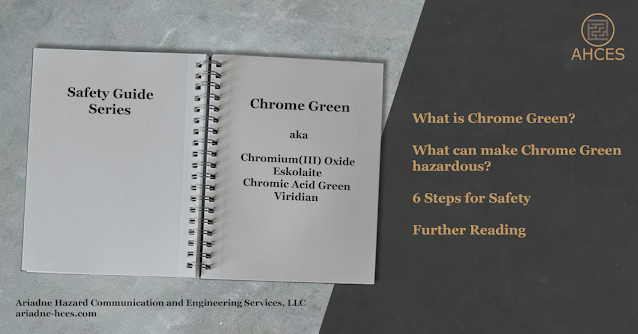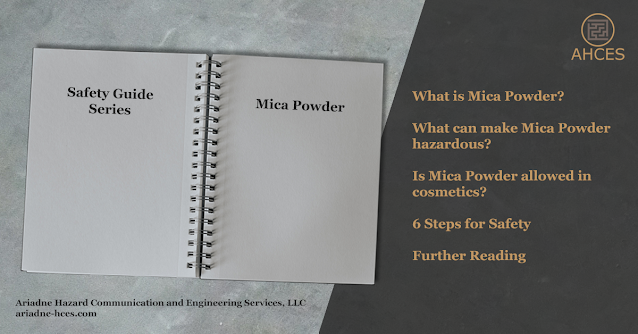Chrome Green Safety Guide
What is Chrome Green?
Chrome Green, also known as chromium(III) oxide, eskolaite, chromic acid green, and viridian, is an inorganic compound. Chrome green is commonly used as a pigment in paints, glass, and banknotes. It also has use in metallurgy and as an abrasive.
Chrome Green has the CAS Number 1308-38-9.
The CAS Number is used to identify chrome green as an ingredient on safety data sheets (SDS) and other safety documentation. When looking for chrome green as an ingredient in products like paints, look for the CAS Number in the composition table.
Notable Properties of Chrome Green
Chrome green is green to blue-green in color and tends to be in a powdered form. It is naturally odorless.
What Makes Chrome Green Hazardous?
Chrome Green is an irritant and can affect the skin, eyes, and respiratory system. In addition to being an irritant, chrome green, along with other chromium compounds, can cause chromium sensitivity. This leads to a chromium allergy.
The toxicity of trivalent chrome is debated, as it is often found in association with the confirmed toxic hexavalent chrome. Trivalent chrome can also be oxidized to hexavalent chrome. Because of the commonality of hexavalent chrome contamination in trivalent chrome products, chrome green is treated as a toxic substance. There has also been some studies that indicate chromium(III) oxide nanoparticles act similarly to hexavalent chrome in cellular influence.
The OSHA permissible exposure limit (PEL) is 0.5 mg/m3 in an 8-hour timespan for chromium(III) oxide.
Hexavalent chrome is irritating to the skin, eyes, and respiratory system. Like trivalent chrome, it can cause chromium allergy. Additionally, hexavalent chromium can cause severe respiratory problems, including respiratory cancer.
Chrome Green Frequently Asked Questions
Is chromium trioxide hexavalent?
The chrome atoms in chrome green or chromium(III) oxide are in the trivalent state, as indicated by the roman numerals (III) within the IUPAC name. The hexavalent state is indicated by the roman numerals (VI).
It is possible for chrome green to be contaminated with hexavalent chrome and it should always be handled accordingly unless it has gone through testing to guarantee it is hexavalent chrome free. Trivalent chrome can also be oxidized into hexavalent chrome, which renders it in the hazardous state.
Is viridian green the same as phthalo green?
No, viridian green and phthalo green are two different pigments. Viridian green is based on chrome green or chromium(III) oxide. Phthalo green is based on copper hexadecachlorophthalocyanine.
6 Steps for Safety
Step 1: Read the Warnings
When working with a product for the first time, always read all the safety documents first. This includes safety data sheets, which should be provided by the manufacturer or importer of the chrome green product. There may also be an OSHA chemical label, a Consumer Protection label, or AMCI label on the packaging of the chrome green product. These documents all contain important information on the hazards of the product and instructions on how to mitigate those hazards.
Different compositions in different products may cause additional hazards to be present beyond the properties of product with chrome green as the only active ingredient. Be sure to familiarize yourself with the differences between separate chrome green based products.
Step 2: Prepare Your Workspace
Creating a safe workspace, sometimes referred to as engineering control, is a key component of working safely with any potentially hazardous substance.
For example, if the chrome green product is in a powder form, then any dust will have to be kept under control. A fan which would blow dust particles around should be avoided. A dust collection with a filter to capture dust is recommended. This is also important when doing activities such as sandblasting or grinding materials that have been painted with a chromium-based paint.
Step 3: Gather Your PPE
For handling chrome green in powder form, you will need
the following PPE.
- Respiratory Protection
- A dust mask meant for inorganic particles will protect the respiratory system from irritation from accidentally breathing in dust particles.
- Eye Protection
- Safety goggles which form a protective seal around the eyes or a combination of safety glasses and a face shield can be used to prevent chrome green dust from reaching the eyes.
Step 4: Clear Your Workspace
Having a clear workspace is an important part of safety. Clutter can cause accidents and can prevent you from noticing if something has spilled.
This is also a good time to double check any engineering controls are in proper working order, such as replacing the filters on a dust collector.
If you are working in a shared space, make sure anyone around you can also remain safe when you are working with chrome green products. For those working at home, this can include family members and pets.
Step 5: Do The Work
If engineering controls and PPE are used properly, and the material is kept away from oxidizers, working with chrome green can be done safely.
If work cannot be completed in one sitting, be sure to properly seal any chrome green containers to prevent spills or accidental release when not in use.
Step 6: Clean Up
Dust generation should be avoided when cleaning up solid chrome green. Either a vacuum with a filter or a damp cleaning cloth can be used to pick up spilled any stray solid chrome green while preventing dust generation.
Be sure to dispose of any waste in accordance with local regulations. This is particularly important with liquid paint products. Many areas require any liquid paints be allowed to completely harden before disposal.
Further Reading
The National Library of Medicine has a PubChem Chrome Green Summary and Hazardous Substances Data Bank Entry on Chrome Green.
OSHA has a webpage with further reading on the health effects of Hexavalent Chromium.
Check out the Safety
Guide Series Hub for more safety guides.
Sources Cited
Bregnbak, D., Johansen, J. D., Jellesen, M. S., Zachariae, C., Menné, T., & Thyssen, J. P. (2015). Chromium allergy and dermatitis: prevalence and main findings. Contact dermatitis, 73(5), 261–280. https://doi.org/10.1111/cod.12436
National Center for Biotechnology Information (2024). PubChem Compound Summary for CID 517277, Chromium(III) oxide. Retrieved January 10, 2024 from https://pubchem.ncbi.nlm.nih.gov/compound/Chromium_III_-oxide.
National Center for Biotechnology Information (2024). PubChem Annotation Record for , Chromium (III) oxide, Source: Hazardous Substances Data Bank (HSDB). Retrieved January 10, 2024 from https://pubchem.ncbi.nlm.nih.gov.
Original Posting Date: Jan. 10, 2024
Last Updated: Feb. 12, 2024






Comments
Post a Comment